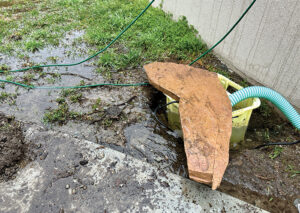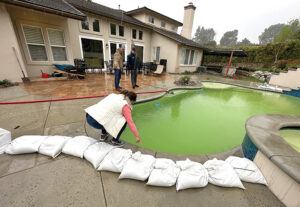Water seeping up from ground floods Claremont homes

Water has been seeping up from the ground at Ken and Anet Larson’s home New Hampshire Avenue since April 9. Courier photo/Peter Weinberger
by Steven Felschundneff | steven@claremont-courier.com
On April 6 several homeowners in the Stone Canyon neighborhood just off Mt. Baldy Road began to notice mysterious flooding in their yards. And then on Monday residents on New Hampshire Avenue and Moody Place noticed similar flooding that seemed to rise directly out of the ground.
Longtime Claremont resident Catherine McIntosh told the Courier she saw water running in the gutters on Appalachian “like everyone had left their sprinklers on,” and water was seeping out of sidewalk cracks.
Homeowners told local news station ABC 7 on Wednesday they have counted at least 27 homes that have been impacted.
“It started Easter Sunday, and it has just gotten worse and worse and getting heavier since then,” said Ken Larsen who lives on New Hampshire.

Ken and Anet Larsen have been pumping out seeping water at their New Hampshire Avenue home since April 9. Courier photo/Peter Weinberger
The first day he had two pumps going to drain the excess water and now he is up to seven. With the help of his wife Anet the couple have been getting up every couple of hours to ensure water is not collecting on the property
“We are not getting any help. We’re on our own. The water is just coming straight out of the ground underneath our property,” Ken Larsen said.
The City of Claremont sent a letter to impacted residents Tuesday regarding the “abnormal groundwater seepage.”
In the letter city officials say the likely source of the flooding is the large amount of water currently being released from San Antonio Dam, following the record setting rainfall this winter.
“Army Corps of Engineers records for the San Antonio Dam show a water level decrease of 20 feet within the last 15 days,” read the letter.
Six Basins Water Master, which manages the local watershed, told city officials on Monday it is conducting spreading operations to recharge the groundwater levels. It also said that the Pomona Valley Protective Association is adjusting this spreading operation to divert water away from the Stone Canyon neighborhood.

Water has been seeping up from the ground at Ken and Anet Larsen’s home New Hampshire Avenue since April 9. Courier photo/Peter Weinberger
During a recent visit to the area directly below the dam, a large amount of water was flowing through drainage ditches which were then diverted to several basins in the wash, creating temporary lakes.
Public Information Officer Bevin Handel said the city does not own, manage, or maintain water systems or services in Claremont. However, the city is doing what it can to assist residents affected by the rising waters.
“City staff from our Building and Engineering Divisions are monitoring the situation and working with homeowners by providing resources for water removal,” Handel wrote in an email. “Staff is also in coordination with the local water agencies that oversee groundwater and water runoff to divert the water from the spreading ground operations and dam release.”

Claremonter Ken Larsen, right, talks to a neighbor about the flooding of his New Hampshire Avenue property. Larsen must inspect the property every two hours to stay ahead of the seeping underground water. Courier photo/Peter Weinberger
Char Miller, the W.M. Keck Professor of Environmental Analysis and History at Pomona College and author of Natural Consequences: Intimate Essays for a Planet in Peril, has a particularly informed view of water in our area. “Fascinating,” he said, when told of the recent flooding in Claremont. “This is what 31 atmospheric rivers will produce: lots of water that can be and should be infiltrated into the aquifers. A reminder, too, that where we choose to build has an impact on how those aquifers function — or rather how we perceive their function. Citrus growers in this same neighborhood would have perceived such flows to be a benefit. Homeowners who have bulldozed this same terrain and sunk their foundations into the alluvial soil, see this water as a threat. And what the [Pomona Valley Protective Association] is doing is exactly what it is supposed to be doing and has done for more than a century — capturing as much of this rainfall as possible and recharging the aquifers to sustain our lives and livelihoods. There is nothing new in this set of conflicting perceptions or in the upwelling of groundwater after a historic year of rainfall. So much fell in the 1980s, that Pomona College dorms began to take on water and the college had to drill another well to relieve the pressure. Nature, in short, reclaims its own — which is as true of droughts and deluges as it is of fire, floods, mudslides, earthquakes.”
The city has delivered sand and sandbags to Padua Park so to assist homeowners in creating barriers around their properties.
“The City urges homeowners to call the City Building Division immediately if you see cracks or signs of damage to your home,” read the city’s letter. “To contact the Building Division, please call (909) 399-5471. Should your property sustain damage, please consult with your homeowner’s insurance to confirm your coverage.”

With her pool water already turning green from seeping groundwater, Anet Larsen inspects the damage on a rainy Thursday morning. Courier photo/Peter Weinberger
Claremont Mayor Ed Reece released a statement: “Ensuring the safety of our residents and property during this water event is paramount. The City will continue to investigate the cause, determine how to mitigate the issue, and continue to support residents of Claremont through the various means possible.”
Courier publisher Peter Weinberger contributed to this story.









0 Comments